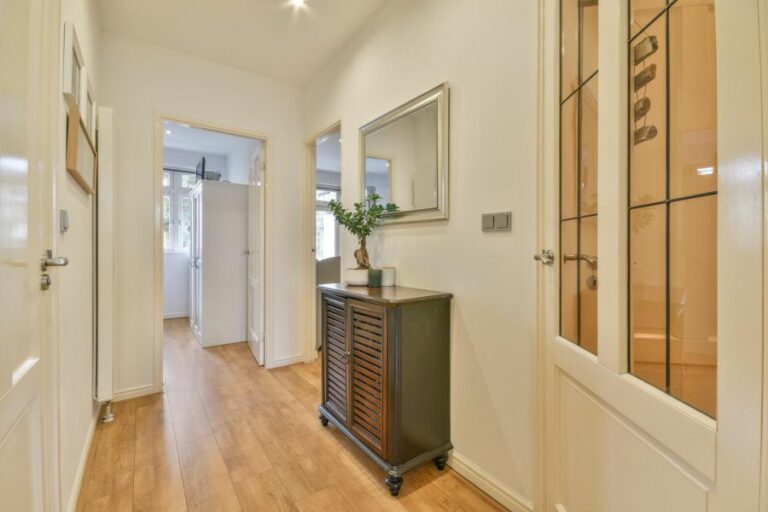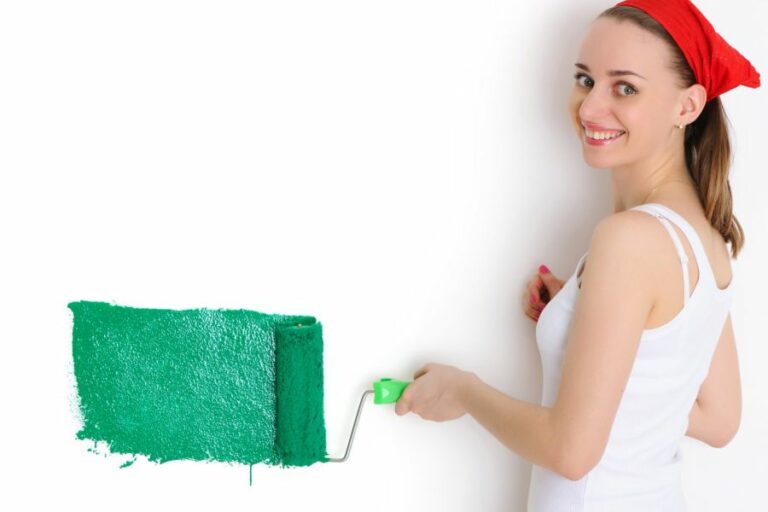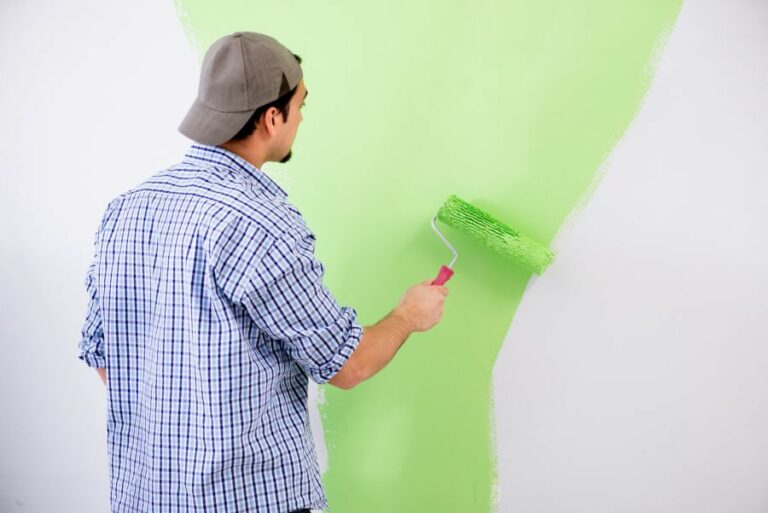Maximizing Small Spaces With The Right Paint. What Pros Say
Are you looking to make the most out of a small space in your home? Do you feel like the walls are closing in and it’s time to make a change? We have the perfect solution for you.
Maximizing small spaces with the right paint:>
To maximize small spaces with the right paint, use light colors like whites and pastels to make rooms appear larger, create a monochromatic color scheme for visual cohesion, and add accent walls with slightly darker shades for depth. Ensure visual continuity by painting built-ins and trim the same color as walls and opt for reflective finishes like eggshell to enhance natural light.

Discover how to revamp your cozy space with the perfect paint color! Our guide shares expert tips on choosing hues that will enhance, expand & transform any small area. Read on to make the most of your compact sanctuary.
Contents
- 1 Enhancing Tiny Areas with Perfect Paint Choices
- 2 Creating an Illusion of Space with Paint Techniques
- 3 Top Paint Colors for Amplifying Small Rooms
- 4 Tips for Optimizing Limited Space Effectively
- 5 Paint Colors to Avoid for Smaller Room Appearance
Enhancing Tiny Areas with Perfect Paint Choices
Small spaces can often feel cramped and claustrophobic, making it essential to find ways of making them appear more spacious and open. One of the most effective ways to achieve this illusion is by choosing the right paint colors and techniques for your walls.
• Light Colors Open Up Spaces
Dark colors tend to absorb light, making spaces feel smaller and more enclosed. On the other hand, light colors reflect light and make rooms appear larger and more open. Therefore, if your goal is to create a sense of space in a small room, choose lighter shades like whites, creams, and pastels for your walls.
Using light-colored paint on walls, ceilings, and trim can make the walls appear to recede, visually expanding the room. Additionally, using the same light color for walls and ceilings can help further blur the boundaries between them, giving your room a more open and cohesive look.
– Expert Recommendation
For those looking to create a soothing and airy atmosphere in their small space, I recommend Behr’s Polar Bear. This barely-there white shade strikes an excellent balance between brightness and warmth, making the room feel open and inviting.
• Monochromatic Color Scheme
A monochromatic color scheme involves using different shades of one color throughout the room. By limiting the color palette, you create a harmonious and visually cohesive space, which can help make it feel more significant than it is.
For instance, if you choose a light gray as your base color, you can use various shades of gray for your walls, furniture, and accessories to create a subtly layered look that can make your space feel larger.
– Expert Recommendation
I recommend exploring a light gray monochromatic color scheme in small spaces. Sherwin Williams Big Chill is an elegant light gray that works well as a base color, and it can be easily coordinated with other gray shades in your decor.
• Accent Walls Add Depth
Creating an accent wall can introduce depth and visual interest to a small room. By choosing a slightly darker or bolder color for one wall, you add dimension and help draw the eye away from the room’s limited size.
It is essential to be careful with the accent wall color choice, as a color that is too dark or bold can make the room feel even smaller. Stick to shades that complement your main wall color and are only a few shades darker or brighter.
– Expert Recommendation
For those looking to add depth to a room with white walls, I recommend Benjamin Moore’s Hale Navy as a perfect accent wall color. This deep, rich blue adds visual interest without overwhelming the space.
• Use Paint to Create Visual Continuity
In small spaces, maintaining visual continuity to minimize any sense of clutter or chaos can help the room feel larger. One way to achieve this is by painting built-ins, cabinets, and shelves the same color as your walls.
By blending these elements into the walls, you create a seamless look that makes the room feel less cluttered and more spacious. Additionally, using the same color for trim, crown molding, and baseboards can create a cohesive and polished look.
– Expert Recommendation
I recommend using the same paint brand and finish for your walls, trim, and built-ins for the best color-matching results. This ensures that your color consistency is maintained throughout the room, creating a seamless look.
• Reflective Finishes Add Light
Using a paint finish with some sheen, such as satin or eggshell, can help reflect light and make a small space feel more open. This effect is especially useful in rooms with limited natural light. However, be cautious about using high-gloss finishes, as they can accentuate imperfections on your walls.
– Expert Recommendation
I recommend using an eggshell finish for most small spaces, as it offers the right balance between reflectivity and the ability to hide minor imperfections.
In conclusion, the right paint color and techniques can have a significant impact on the perception of your small space. By using light colors, monochromatic schemes, accent walls, visual continuity, and reflective finishes, you can make your small space feel larger and more inviting.
For more ideas and inspiration, visit the Interior Design department at your local university or consult with a professional interior designer.
Creating an Illusion of Space with Paint Techniques
A well-selected paint color can dramatically transform the appearance of a small space, creating the illusion of spaciousness and enhancing the overall ambiance. With the right techniques and knowledge, anyone can make the most out of their limited square footage.
• Choose the Right Paint Color
Selecting the appropriate paint color is crucial in achieving the desired effect. Colors can create a perception of depth and set the mood for the space. Here are some recommendations:
– Light Colors
Painting walls with light colors can make a room appear brighter and more spacious. Light colors, such as white or pale pastels, reflect natural light, which creates a sense of openness.
Light colors also minimize the contrast between walls and other elements in the room, making it less cluttered and more cohesive.
– Cool Colors
Cool colors, such as blues, greens, and grays, create an illusion of depth by visually receding into the background. This effect can make a room appear larger by drawing your attention to the distant corners. In addition, cool colors provide a calming effect that can make a small space feel less cramped.
– Monochromatic Color Scheme
Using a single color or shades from one color family can make a space look larger. By reducing contrast and promoting continuity within the space, a monochromatic color scheme establishes a sense of unity and flow that makes the room feel more expansive.
• Painting Techniques to Enhance Space
Apart from color selection, various painting techniques can also influence the appearance of a small room. Experiment with some of these methods to create a sense of depth and openness:
– Use a Lighter Ceiling Color
Painting the ceiling with a color lighter than the walls can create a sense of height, making the space feel open and airy. A white or light-colored ceiling also reflects light, brightening the room and contributing to the perception of spaciousness.
– Incorporate Vertical or Horizontal Lines
Adding stripes or lines to the walls can manipulate the room’s dimensions. Vertical lines will make the walls appear taller, while horizontal lines can make them look wider. Choose the type of lines that best complements your room’s natural shape to accentuate its proportions.
– Utilize Paint Finishes
Selecting the appropriate paint finish can significantly impact the room’s appearance. Glossy finishes reflect light better than matte finishes, creating a brighter and more open space. However, keep in mind that reflective finishes can highlight imperfections on the walls.
On the other hand, matte finishes provide a more uniform look, ideal for hiding wall imperfections but offering less light reflection.
– Highlight Architectural Features
Accentuating architectural elements, such as moldings or built-in shelves, can create focal points and a sense of depth. Painting these features with contrasting colors or shades adds visual interest and depth to the walls, making the room feel more spacious.
• Additional Tips and Tricks
Aside from paint color and techniques, here are some extra suggestions to make your space look larger:
– Use Mirrors
Mirrors can amplify natural light and create a sense of depth by reflecting the room’s contents. Strategically placing a mirror near a window or light source will maximize its effect.
– Opt for Smaller Furniture
Large, bulky furniture can fill a small space quickly and make it appear more confined. Instead, use smaller, multipurpose furniture pieces to preserve the room’s openness.
– Declutter
Keeping a small space clean and organized will make it look more expansive. Reduce visual clutter by putting away unnecessary items and using compact storage solutions.
– Utilize Natural Light
Maximizing natural light can make a small space feel bright and airy. Use light window treatments that allow sunlight to enter the room, and avoid placing large furniture near windows to optimize light distribution.
For more inspiration and advice on making small spaces look bigger, check out the Small Space Design page hosted by the University of Kentucky’s College of Design (source). Use these recommendations and suggestions to transform your small living space into a brighter, more expansive haven.
Method | Description |
|---|---|
Use light colors | Light colors reflect more light, making the room feel more open and spacious. |
Choose a monochromatic color scheme | Using different shades of the same color creates a seamless look that makes the space feel larger. |
Use cool colors | Cool colors, such as blues, greens, and purples, give the impression of receding and can make a room feel bigger. |
Paint the ceiling lighter than the walls | A lighter ceiling creates the illusion of a higher ceiling and more open space. |
Use horizontal or vertical stripes | Stripes can elongate a room or make it seem wider by drawing the eye up or across the space. |
Paint an accent wall | An accent wall can create a focal point and give the illusion of depth in a small space. |
Top Paint Colors for Amplifying Small Rooms
– Introduction
Everybody dreams of having spacious, well-lit rooms in their homes. However, not everyone has the luxury of space. Thus, one may wonder how to create an illusion of a larger space in a small room. The answer to this question lies mainly in the right color selection.
Careful color choices can significantly impact a room’s overall appearance by making it look more expansive and attractive.
– Understanding Color Psychology
Colors have a psychological effect on how we perceive space. For example, cooler colors tend to recede, creating an illusion of distance, while warmer colors appear to advance, making a room feel smaller.
Therefore, understanding the psychology behind colors becomes key in choosing the perfect shade for a small room. The Color Association of the United States, for example, offers useful insights into the world of colors and their effects on our perception.
– Light Colors: The Go-To Option for Small Spaces
As a general rule of thumb, lighter colors, especially soft, neutral shades, make a room look bigger. Light colors tend to reflect natural light, making any space feel open and airy. Some of the best light tones to consider include white, beige, and light gray.
White: The Classic Choice
White is a timeless color that significantly enhances the sense of space. It reflects natural light around the room, making the area appear larger and brighter. When choosing a shade of white, consider one that is not too stark, as this may sometimes feel too sterile.
An off-white, like eggshell or ivory, can create a softer and more inviting atmosphere.
Beige: The Warm Neutral
Beige is another great option for opening up a small room. It provides a touch of warmth while still maintaining a neutral tone. The different shades of beige, ranging from pale cream to soft tan, provide ample choice for finding the perfect color that best suits your room.
Light Gray: The Modern Neutral
Less conventional but increasingly popular, light gray has become a go-to color for modern interior designs. It can create an elegant and sophisticated atmosphere while also maintaining a sense of spaciousness. Pair light gray with white or other light-colored accents for an even more expansive effect.
– Cool Colors to Amplify Space
Other than light neutral colors, cool colors, such as soft blues and greens, are also fantastic choices for making a room feel more spacious. As explained earlier in color psychology, these colors tend to recede, creating an illusion of depth and distance.
Soft Blues: Serenity and Space
Soft blues, reminiscent of the sky or ocean, can create a sense of calm and openness in a small room. Light shades, such as powder blue, are fantastic for creating a serene ambiance while making a room appear bigger.
Pale Greens: Bringing Nature Indoors
Pale greens, like soft mint or light sage, emulate the freshness of nature, making a room feel more expansive and connected to the outdoors. Pairing these shades with natural materials and botanical elements further enhances the perception of a larger space.
– Color Techniques for Maximizing Space
Monochromatic Color Scheme
Utilizing a monochromatic color scheme, where various shades of a single hue are combined, not only creates a visually cohesive space but also makes it feel larger. This technique eliminates harsh contrasts that can make a room appear smaller.
Incorporating Accent Colors
Incorporating accent colors through decorations, furniture, or smaller furnishings adds visual interest and depth to a room without overpowering the light and spacious feel. Ensure that the accent colors still complement the main color palette to maintain a sense of cohesion and unity.
– Conclusion
Color selection undoubtedly plays a significant role in the appearance of a room, especially when space is a constraint.
By understanding the psychology behind colors, opting for light neutral, and cool shades, and implementing strategic color techniques, a small room can be transformed into a visually stunning, more expansive space.
Question | Best Color |
|---|---|
What is the best color to make a small room look bigger? | Light colors, such as white, light gray, or light blue |
Tips for Optimizing Limited Space Effectively
Small spaces can prove to be quite challenging when it comes to designing and organizing. Yet, with a few expert tips and strategies, you can maximize your small space without sacrificing functionality or style.
• Smart Furniture Selection
One of the most critical aspects of maximizing small spaces is choosing the right furniture. Opt for functional, multi-purpose pieces that offer storage solutions while taking up minimal space.
– Opt for Furniture with Storage
Select pieces of furniture that serve multiple purposes and include built-in storage. For instance, a bed with built-in drawers underneath provides space for clothes or linens, while a coffee table with shelves can store books or magazines.
This source from the University of Notre Dame’s School of Architecture provides various tips and inspiration for storage solutions in small spaces.
– Choose Stackable and Foldable Furniture
Opt for stackable chairs or nesting tables, which can be quickly put away when not in use. In addition, foldable furniture such as desks and dining tables can be easily stored against the wall, freeing up valuable floor space.
• Effective Organization
Even if you have limited space, keeping your surrounding area tidy and organized can create the illusion of more room. Follow these organization tips to maintain a clutter-free environment.
– Use Vertical Space
Take advantage of wall space by installing shelves, hooks, and storage units. Wall-mounted shelves can store books and decorative items, while hooks can hold clothing and accessories. Floating corner shelves are another great option to utilize vertical space effectively.
– Invest in Drawer Organizers and Bins
To optimize storage spaces like drawers and closets, use organizers or bins to separate items into specific categories. This way, it is easier to find what you need and prevents clutter from accumulating.
For example, separate your kitchen utensils by type, or sort your clothing into different piles based on season or function.
• Strategic Use of Color, Lighting, and Decor
A well-thought-out color palette, combined with the right lighting and decor, can help create the illusion of a larger room. Consider these tips when planning your room’s design.
– Light and Neutral Colors
Light and neutral colors can make a small space appear larger, reflecting more light and creating a sense of openness. Consider painting your walls, furniture, or even ceiling in shades of white, beige, or light gray to make the room feel spacious and airy.
– Mirrors and Reflective Surfaces
Mirrors are an excellent tool for creating the illusion of a larger space. A strategically placed mirror can reflect light and make the room appear brighter and more open. Additionally, incorporating furniture and decor with mirrored or reflective surfaces can help magnify the effect.
– Use Natural and Artificial Lighting
Good lighting is essential for making a small space feel more expansive. If possible, ensure that the room receives ample natural light by keeping window treatments minimal and unobtrusive.
To enhance the room’s brightness, opt for artificial lighting solutions such as floor lamps, table lamps, and wall sconces, all of which contribute to a pleasant and inviting atmosphere.
• Optimize Room Layout and Functionality
Lastly, choose a layout for your small space that maximizes its functionality. Careful arrangements of furniture and accessories can create distinct, separate areas within the space, making it more practical and enjoyable.
– Create Zones
Divide your small space into distinct areas, such as a living area, dining area, and workspace. This can be achieved using furniture placement, area rugs, or even room dividers, giving each zone a clear purpose and making the overall space feel more cohesive.
– Opt for Smaller, Leggy Furniture
When selecting furnishings for small spaces, it is essential to choose carefully. Smaller, leggy furniture can make the room feel less crowded, while long, sleek lines create a sense of openness. In addition, choose furniture with slim profiles to avoid a bulky appearance.
In conclusion, maximizing small spaces can be achieved through strategic furniture selection, effective organization, and the use of color, lighting, and decor.
By incorporating these expert tips and strategies, you can transform your small space into a functional, stylish, and comfortable environment. Remember, the key is to prioritize functionality and storage solutions while also creating an inviting and aesthetically pleasing space.
Methods | Description |
|---|---|
Utilize vertical space | Use shelves, wall-mounted storage, and tall furniture to make use of the space above the floor level. |
Choose multifunctional furniture | Select furniture pieces that serve multiple purposes, such as a sofa bed or a table with storage compartments. |
Use mirrors | Strategically placed mirrors can make the space feel bigger by reflecting light and creating an illusion of depth. |
Keep it clutter-free | Ensure that your small space is always clean and organized to create a more spacious and comfortable environment. |
Opt for light and neutral colors | When decorating, choose light and neutral colors for walls and furniture to make the space feel open and airy. |
Utilize hidden storage | Make use of hidden storage compartments such as under-bed storage, built-in closets, and storage ottomans. |
Paint Colors to Avoid for Smaller Room Appearance
When redecorating a space, one of your primary considerations should be the paint color you choose. The color you select can significantly influence the perception of room dimensions, either making a room appear larger or smaller.
• Dark Colors: Creating an Intimate Ambiance
It is no secret that dark colors absorb light and visually shrink an area. If you want to create an intimate, cozy environment, consider painting your walls with darker shades or adding a darker accent wall. Some of the most popular options include:
- Deep shades of blue or green, such as navy, hunter green, or charcoal
- Rich, earthy tones, like chocolate brown or burgundy
- Darker shades of gray, from slate to graphite
These colors can work well in smaller rooms, like a home office, a bedroom, or a den, where you want to encourage relaxation and a sense of privacy.
• Bold Colors: Making a Statement
While dark colors are known to make a room appear smaller, don’t shy away from vibrant, bold colors if you want to create a dramatic, statement-making space.
Although these shades can also shrink the perceived dimensions of a room, they provide an opportunity to inject personality and character. Some suggestions include the following:
- Rich jewel tones, such as ruby red or emerald green
- Saturated colors like mustard yellow, tangerine, or fuchsia
- Statement shades, like black or deep purple
When using bold colors in a smaller space, ensure that you balance them with lighter, neutral elements to avoid overwhelming the room. For instance, you might paint an accent wall in a bold hue and choose furniture and accessories in light or neutral tones.
• The Ceiling: Don’t Neglect This Essential Element
Remember to consider how the ceiling color impacts a room’s dimensions. If you’re aiming for a smaller, more intimate space, painting the ceiling a darker shade than the walls will create a visually lower ceiling. This technique can help to enclose the room and make it feel more intimate.
• The Power of Color Combinations and Accents
While the primary color you choose for your walls and ceiling will have the most significant impact on a room’s perceived size, don’t overlook the importance of color accents and combinations.
By introducing small doses of color through accessories, furniture, or artwork, you can create a cohesive design scheme that enhances the room’s overall appearance.
Following are some useful tips and tricks to help you nail the perfect smaller-room look:
- Monochromatic Color Schemes: Stick to a single color palette by using various shades of the same color. This strategy can create a harmonious, intimate atmosphere within the room. An article on color theory explains the benefits of a monochromatic color scheme.
- Texture and Patterns: Add visual interest to the space through textured surfaces, patterns, or materials. These elements can break up solid blocks of color and create a visually appealing, cozy atmosphere.
- Furniture and Accessories: Opt for furniture and accessories that complement the wall color. By choosing items in similar or contrasting shades, you can create a cohesive, intentional design that makes the room feel more intimate.
• In Summary: Size is Relative
If you want to create the illusion of a smaller room, focus on using dark or bold paint colors, mindful ceiling colors, and thoughtful color combinations throughout the space.
By skillfully manipulating these elements, you can transform any area into an intimate, comfortable retreat. Remember to take your time in choosing the perfect shades and finding the right balance, as meticulous attention to detail can significantly impact the overall look and feel of your space.







